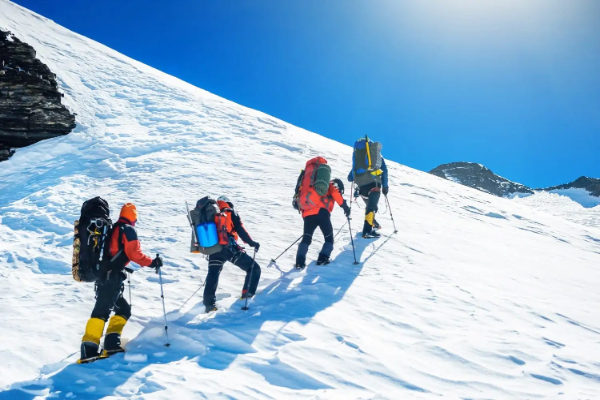Mountaineering, also known as alpinism, involves climbing mountains. It can include hiking, rock climbing, ice climbing, and traversing glaciers. Some argue it’s a lifestyle or an adventure, while others see it as a sport. This article explores the debate and provides insight into whether mountaineering is truly a sport.
Understanding Mountaineering
Mountaineering is the activity of climbing mountains. It requires physical strength, endurance, and mental toughness. Climbers face various challenges, including altitude, weather, and difficult terrain. They need specialized equipment like ropes, harnesses, and ice axes.
Detailed Training Regimes for Mountaineers:
Mountaineering requires physical fitness, mental strength, and technical skills. A typical training regime for a mountaineer might include:
- Cardiovascular Training: Long-distance running, cycling, or swimming to build endurance.
- Strength Training: Weightlifting, especially focusing on legs and core muscles.
- High-Altitude Training: Climbing hills or stairs with a weighted backpack to simulate high-altitude conditions.
- Technical Skills: Learning knots, rope management, crevasse rescue, and other mountaineering techniques.
- Mental Preparation: Meditation, visualization, and stress management techniques.
Specific Examples of Famous Mountaineers and Their Achievements:
- Sir Edmund Hillary and Tenzing Norgay: The first climbers to reach the summit of Mount Everest in 1953.
- Reinhold Messner: The first solo ascent of Everest in 1980 and the first ascent without supplemental oxygen in 1978.
- Alex Honnold: The first free solo climb of El Capitan in Yosemite National Park in 2017.
A Deeper Dive into the History of Mountaineering:
Mountaineering has a long history, with some of the earliest recorded ascents dating back to ancient times. However, modern mountaineering began in the 18th century with the Alps, and the first ascent of Mont Blanc in 1786. The Golden Age of Mountaineering was in the mid-19th century, with notable achievements such as the first ascent of the Matterhorn in 1865.
Exploration of Mountaineering Equipment and Technological Advancements:
Mountaineering equipment has evolved significantly over time. Early climbers used simple ropes, wooden planks, and leather shoes. Today, climbers use high-tech materials such as Gore-Tex, carbon fiber, and titanium. Technological advancements like satellite communication, GPS, and weather forecasting have also improved safety and success rates.
The Environmental Impact of Mountaineering:
Mountaineering can have negative environmental impacts, including littering, erosion, and damage to flora and fauna. Responsible tourism practices, such as leaving no trace and respecting local cultures, are essential for minimizing these impacts. Some mountains, like Everest, have implemented strict regulations to mitigate environmental damage.
See Also: Is Downhill Mountain Biking Dangerous
The Physical Demands of Mountaineering
Mountaineering demands physical fitness. Climbers must be strong and have good cardiovascular health. They often train for months to prepare for a climb. This training includes running, weightlifting, and practicing climbing techniques.
Technical Skills in Mountaineering
Mountaineering requires technical skills. Climbers need to know how to use equipment, navigate terrain, and ensure safety. They must be able to read maps, use compasses, and understand weather patterns.
Mental Challenges in Mountaineering
Mountaineering is mentally challenging. Climbers face fear, stress, and exhaustion. They must stay focused and make quick decisions in dangerous situations. Mental toughness is crucial for success.
Is Mountaineering a Sport?
To determine if mountaineering is a sport, we must define “sport.” According to the Oxford Dictionary, a sport is an activity involving physical exertion and skill in which an individual or team competes against another or others for entertainment. Let’s break down this definition in the context of mountaineering.
Physical Exertion
Mountaineering involves significant physical exertion. Climbers need strength, endurance, and agility. They face harsh conditions, which require them to be in peak physical condition.
Skill
Mountaineering requires a high level of skill. Climbers must know how to use their equipment, navigate the terrain, and ensure their safety. These skills are learned through training and experience.
Competition
Competition in mountaineering is less direct than in traditional sports. Climbers often work together to reach the summit. However, there is a competitive aspect in terms of personal achievement and setting records. Climbers may compete to be the first to summit a peak or to complete a climb in the shortest time.
Entertainment
Mountaineering can be entertaining to watch. Documentaries and films about mountaineering are popular. People are fascinated by the challenges and achievements of climbers.
The Sporting Community
Mountaineering has a community of enthusiasts and professionals. There are organizations, clubs, and competitions. Climbers share their experiences, train together, and support each other.
Mountaineering Competitions
There are mountaineering competitions, though they differ from traditional sports. Events like speed climbing and climbing festivals showcase skills and endurance. These competitions add a structured, competitive element to the activity.
Mountaineering in the Olympics
Mountaineering is not an Olympic sport. However, sport climbing, a related discipline, is part of the Olympics. This inclusion reflects the growing recognition of climbing as a sport.
Comparing Mountaineering to Other Sports
Comparing mountaineering to other sports helps us understand its nature. Sports like marathon running, cycling, and triathlons also involve physical exertion, skill, and competition. Mountaineering shares these characteristics but in a unique context.
The Lifestyle Aspect of Mountaineering
For many, mountaineering is more than a sport. It’s a lifestyle and a passion. Climbers dedicate their lives to exploring mountains. They form a deep connection with nature and the outdoors.
Conclusion
Mountaineering involves physical exertion, skill, and competition, fitting the definition of a sport. However, it is also a lifestyle and a personal journey. Whether viewed as a sport or an adventure, mountaineering remains a challenging and rewarding pursuit.

